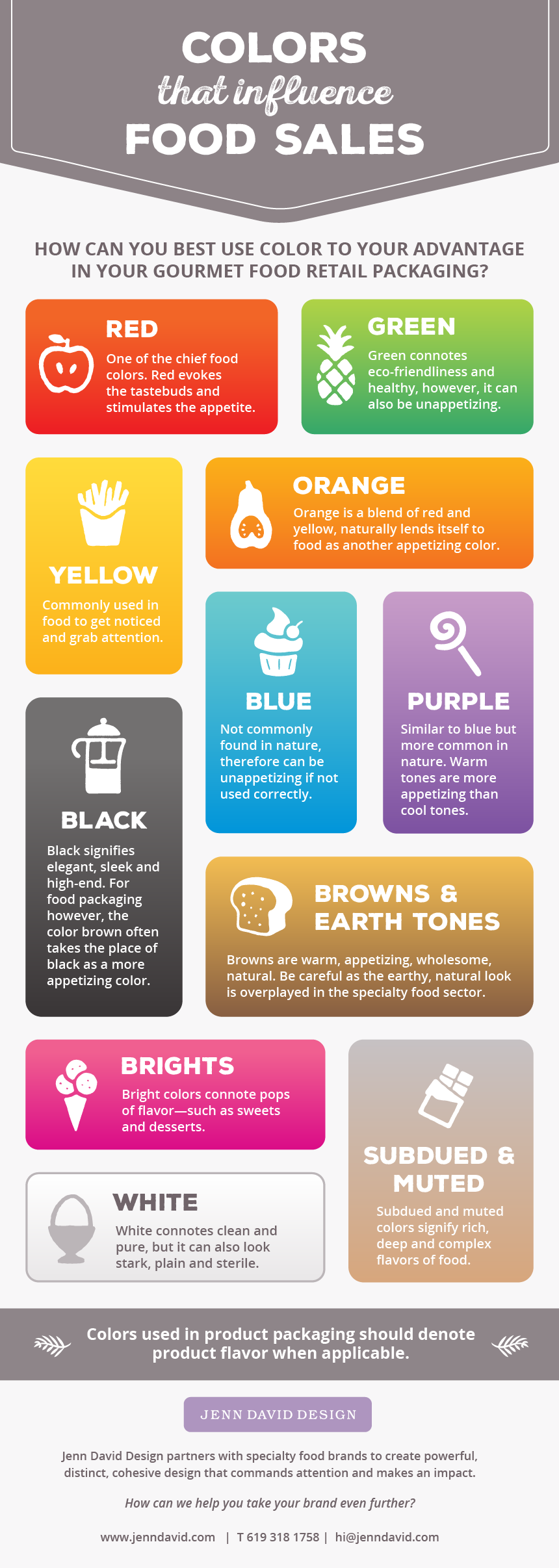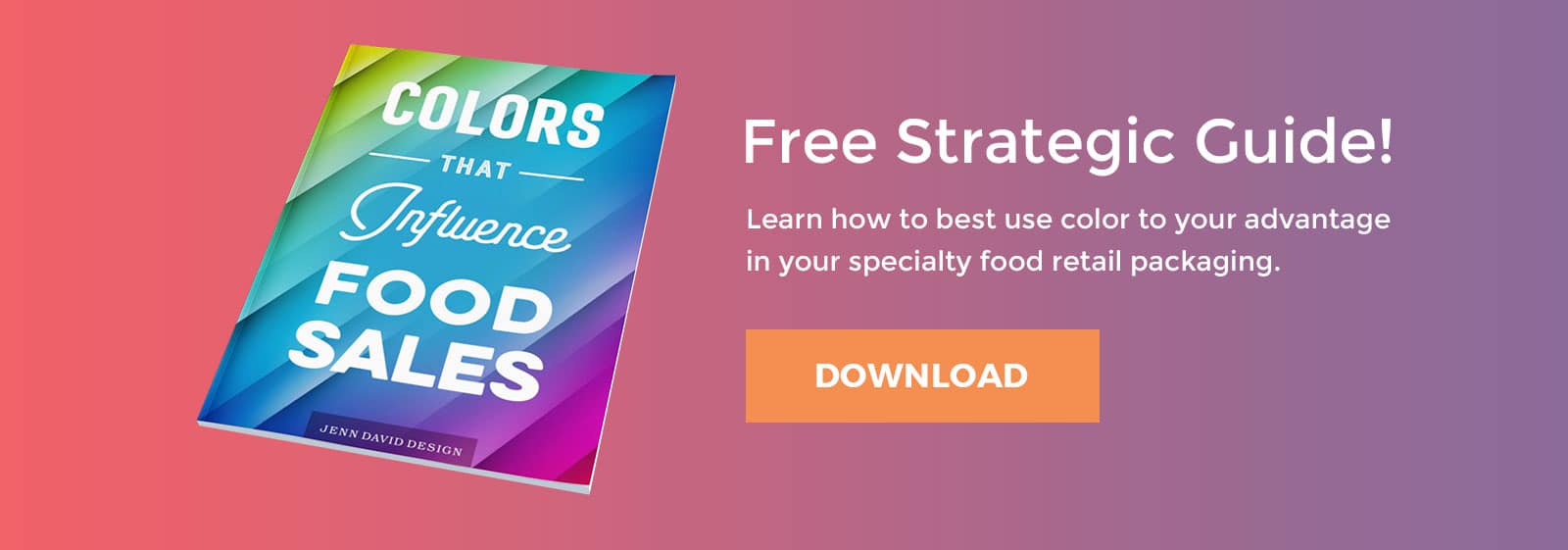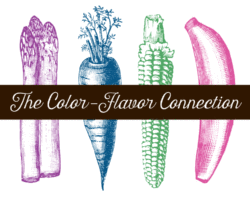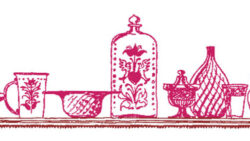Color influences consumers not only on the conscious level but also on the subconscious level. Color and food pairings can be especially powerful by leveraging the emotional connection to taste. How can you best use color to your advantage in your gourmet food retail packaging?
Red and yellow are the chief food colors, evoking the tastebuds and stimulating the appetite. Both red and yellow are also effective at grabbing attention. The fast food industry has claimed this combination for a good reason—because it is effective. In the gourmet food arena, you of course want to avoid a fast food connotation, however these colors can still be very effective when used on their own and/or in different pairings.
Orange, a blend of red and yellow, naturally lends itself to food as another appetizing color. Orange has been a trendy color for some time now, so be aware of that when using it—its popularity could either work for or against your product depending on its context and intent.
Green connotes eco-friendliness, healthy (think veggies) but be careful as green can be also unappetizing. The eco side connection to green has been overdone, and it’s no longer expected that eco products will actually be colored green since eco has become more the norm and less the exception.
Blue and purple are cool tones, and can be unappetizing if not done correctly. Cool tones don’t stimulate the appetite as much therefore careful context and application must be considered.
White connotes clean and pure, but it can also look stark, plain and sterile—so this is another color that needs to be exercised with care.
Black signifies elegant, sleek and high-end. For food packaging however, the color brown often takes the place of black as a more appetizing color which can still be portrayed with the same descriptors as black.
Browns and earth tones are warm, appetizing, wholesome, natural. Be careful as the earthy, natural look is overplayed in the specialty food sector. As with eco-friendliness, natural food products have transcended earth tone colors as consumers now see natural in so many products and no longer expect them to have the typical “earthy” look.
Bright colors connote pops of flavor—such as sweets and desserts. Fun color combos can be applicable to fun foods like candy.
Subdued, muted colors signify rich, deep and complex flavors. These tones often work well for savory flavors but are also suitable for rich, sweet flavors like chocolate.
Colors used in product packaging should denote product flavor when applicable. A blueberry-flavored product in an orange color doesn’t work in the brain—the brain needs to immediately get it without thinking. Remember, your product only has a 2–3 second window in front of the consumer on the retail shelf. Reinforce flavor visually (including imagery where applicable, not just color) to trigger as many senses as possible, even subconsciously. Food has the added advantage of conjuring up taste, smell, memories and feelings, so use this to your advantage in your overall product packaging to make that instant emotional connection with the consumer.







I was going to compliment you on addressing the use of color in labeling/packaging, but the website font colors are very difficult to see. Nonetheless, it is good you addressed this obvious marketing tool. One of our most-used products is now being purchased only 1/10th of the time, because the product label was changed to one of these bland, almost no-color labels. It is unappetizing. It is unappealing. The company has lost hundreds in sales from us due to that one aspect. We find that even the taste of the product seems altered; that is how hard-wired the brain-taste as related to label/packing had become.
We are also vehemently opposed to the business of “dumps” for foods I grocery stores. Even canned goods are thrown into these dumps, and, as most people will acknowledge, a dented can is not a can you pay full price for. You consider the billions of dollars spent in getting food packaging right, so that there is not spoilage, so that the product stays as fresh and good-looking as possible, and then they put it in one of these blasted “dumps.” As if all of that was meaningless. This practice, too, is idiotic. And, as many complaints as they receive, they don’t seem to care. Bizarre.
Hello,
Do you have any research or sales stats to back up any of this? I am actually doing a thesis on the impact and influence packaging has in packaging and marketing and to what extent that sways buying habits.
I’d really appreciate any extra info you may have to back this up 🙂
Hi Vanessa,
This article is based on my experience working and studying in the field. I have not documented any studies.
Best,
Jenn
What’s the best color I can use for a frozen food shop( Frozen chicken, fish and drinks) for both the packaging and the small shop painting, I will appreciate if you can help with an idea.
Hi Que,
Based on just the information you’ve mentioned, the uniting theme of the products is that they are all frozen. A pale blue could work to signify frozen while warm yellows and browns could represent the meat. Oranges and reds also could connote meat. Good luck!
Best,
Jenn
Hello and thanks for this valuable info,
I am planning on launching an assorted cookie (petit-fours) brand.
1- what colors do you think I should use?
2-I would like to make the tin colorful? would that be too much and unappealing?
Thanks in advance
Maggie
Hi Maggie,
A logical approach would be to base the packaging colors on the petits fours colors if they are colorful. You want the packaging to be an extension of the product inside since the consumer won’t be able to see the product, assuming this is a retail product.
If the petits fours will be packed in-store with the consumer picking the products to go inside at the point of sale (or online), then that would require a different approach. A streamlined, simpler, perhaps minimal-color approach would likely be more suitable. In this case the tin is simply a vehicle to house the product. In the retail case, the tin is a marketing tool to represent and sell the product.
If retail, and the product and package are both colorful, you want to be sure the packaging doesn’t overwhelm or diminish the product inside. The packaging should represent and be an extension of the product.
Best,
Jenn
I appreciate your input.
Regards,
Maggie
Hello,
Nice insightful article. I’m getting into cake and pastry business, do you have any suggestions on the colours that would be suitable for the logo?
Hi Kim,
The cake and pastry business is sweet, enjoyable and fun. You could take this approach with pairing bright, contrasting but complementary colors. Or if you’re targeting a more upscale audience with luxury sweets you could go minimalist in color and design, pairing a dark, timeless color with a pale muted color. A favorite site of mine for color inspiration is http://design-seeds.com. Good luck!
Best,
Jenn
Hi Jenn,
Just discovered your site today. So informative! Thank you.
I’m working on launching my packaged sugar brand in a windowed paper packaging. What colours do you think I can use on the paper packaging? My competitors are currently using green, yellow, orange combos.
Thanks
Hi Angie,
The simple answer is you can use any colors as long as they work and don’t look like your competitors. Which specific colors work best really depend on your brand, and the personality of the brand and product. Sugar is sweet and can be fun or sophisticated, so there are a number of directions you could take this in. I recommend thinking about it more in terms of which design style goes with the personality of the brand and product, get a design in progress then select colors from there. Good luck and have fun!
Best,
Jenn
Hi Jenn,
your article on food color packaging was mighty helpful.
Thank you.
would you suggest any particular color packaging to be used for coconut products like
desiccated coconut, virgin coconut oil, coconut flour, coconut sugar.
Thank you
Hi Richa,
There are a plethora of coconut products on the market, so in any given category there are bound to be numerous competitors. Colors that are naturally suited to coconut products are blues, greens, browns, tans and whites – as these are the colors found in or near coconuts in nature. Blue for water/tropical, green leaves/young coconuts, brown husks and trunks, tan sand, white flesh and milk. Many coconut products also show an image of a coconut fruit or tree.
Therefore when designing for crowded categories such as for coconut products, where many products have common colors or elements, it’s essential to make sure your product stands out. That could mean using different colors, different imagery or similar imagery in a different way, different packaging, using the design to stand out or all of the above. Assess competitors, retail environment, target audience and make sure you’re making strategic decisions and not just doing something randomly wacky for the sake of standing out.
Best,
Jenn
We are in the process of launching an adult soft drink and are looking into the psychology behind colours
I guess if you think about it many fast food chains use red or bright colors. Healthy ones maybe green and weight watchers has blue, green and yellow. Blue being to curb appetite. How interesting it is to take a closer look at the meaning behind emotions and color.
I am looking at doing milk kefir from our cows who are allowed to keep their babies. Happy cow farm.
What colours would you suggest for the packaging?
Also would a real life photo of my children laying in the pasture with the cows be appropriate to put on the bottle or just for advertising?
Kind regards,
Kellie
Hi Kellie,
What a wonderful concept!
Without knowing more about the product or brand, I would say it’s entirely appropriate to do a fresh, clean look with blues and greens for nature, maybe some yellow for sunshine, lots of white for purity. If you have room to write a little brand story blurb on the package, I recommend putting the photo of your kids there – it will be memorable and help with a strong emotional connection.
Best of luck as you move forward with your product!
Jenn
I’m a student at Midway College in Kentucky. I’m working on a Marketing project in marketing class. We are to design a marketing plan for a new product. I love to cook, so I’ve gone with designing a new food recipe and app. I was wondering, are there shapes also that create a desire for food choice, and help sell food?
Appreciative of your insight,
Sincerely,
Theo Courrejolles
Student – Midway College
Hi Theo,
That’s a great question! Much like any element in a design, it depends on the overall design and how the elements and colors are used within the context of the design. It also depends on the type of product, how it’s packaged, and the audience you’re marketing to.
In a general sense though, strong, solid shapes can help ground the design and can help create the impression of trust and reassurance, and can also help with a more impactful connection (both visually and emotionally). Round shapes and shapes with rounded edges can help create more approachability with the product, and can make it seem more “friendly.” For example, if rectangles are used in the design, rounding the corners slightly can help give a slightly different feel to the design, even if on a subconscious level to the consumer.
Pointy shapes like triangles and bursts can be off-putting if too pointy or if not integrated well into the design.
Good luck!
Jenn